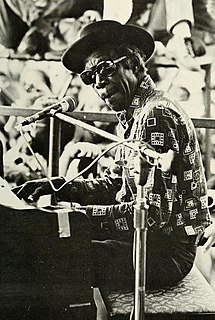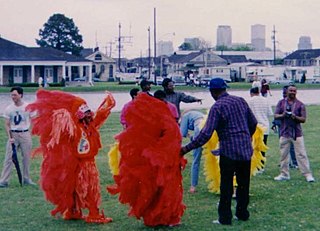Related Research Articles

Henry Roeland "Roy" Byrd, better known as Professor Longhair or "Fess" for short, was an American singer and pianist who performed New Orleans blues. He was active in two distinct periods, first in the heyday of early rhythm and blues and later in the resurgence of interest in traditional jazz after the founding of the New Orleans Jazz and Heritage Festival in 1970. His piano style has been described as "instantly recognizable, combining rumba, mambo, and calypso".

Alois Maxwell "Al" Hirt was an American trumpeter and bandleader. He is best remembered for his million-selling recordings of "Java" and the accompanying album Honey in the Horn (1963), and for the theme music to The Green Hornet. His nicknames included "Jumbo" and "The Round Mound of Sound". Colin Escott, an author of musician biographies, wrote that RCA Victor Records, for which Hirt had recorded most of his best-selling recordings and for which he had spent much of his professional recording career, had dubbed him with another moniker: "The King." Hirt was inducted into The Louisiana Music Hall of Fame in November 2009.

The holiday of Mardi Gras is celebrated in all of Louisiana, including the city of New Orleans. Celebrations are concentrated for about two weeks before and through Shrove Tuesday, the day before Ash Wednesday. Usually there is one major parade each day ; many days have several large parades. The largest and most elaborate parades take place the last five days of the Mardi Gras season. In the final week, many events occur throughout New Orleans and surrounding communities, including parades and balls.

Mardi Gras Indians are black carnival revelers in New Orleans, Louisiana, who dress up for Mardi Gras in suits influenced by Native American ceremonial apparel.
Joseph Charles Jones was an American R&B singer, songwriter and arranger, who was born in New Orleans, Louisiana. Jones is also generally credited with discovering the Dixie Cups. He also worked with B.B. King. As a singer, Jones had his biggest hit in the form of the Top Five 1960 R&B hit "You Talk Too Much", which also reached No. 3 on the Billboard Hot 100 chart.
Huey Pierce Smith, known as Huey "Piano" Smith, is an American rhythm-and-blues pianist whose sound was influential in the development of rock and roll.

The Zulu Social Aid & Pleasure Club is a fraternal organization in New Orleans, Louisiana which puts on the Zulu parade each year on Mardi Gras Day. Zulu is New Orleans' largest predominantly African American carnival organization known for its blackfaced krewe members wearing grass skirts and its unique throw of hand-painted coconuts. The club is a regular feature of the New Orleans Jazz & Heritage Festival.

Monk Boudreaux is the Big Chief of the Golden Eagles, a Mardi Gras Indian tribe. He is widely known for his long-time collaboration with Big Chief Bo Dollis in The Wild Magnolias.

Wardell Joseph Quezergue was an American composer, arranger, record producer and bandleader, known among New Orleans musicians as the "Creole Beethoven". Steeped in jazz, he was an influential musician whose work shaped the sound of New Orleans rhythm and blues, funk and pop music. His role as an arranger and producer kept him out of the spotlight and enabled him to enhance the careers of many. He was a staple of the New Orleans music scene and the recipient of an honorary doctorate in music.

Joseph "Smokey" Johnson Jr. was an American drummer. He was one of the musicians, session players, and songwriters who served as the backbone for New Orleans' output of jazz, funk, blues, soul, and R&B music.

Al "Carnival Time" Johnson is an American singer and piano player best known for the Mardi Gras song "Carnival Time".

James "Sugar Boy" Crawford, Jr. was an American R&B musician based in New Orleans. He was the author of "Jock-A-Mo" (1954), which was later rerecorded as "Iko Iko" by the Dixie Cups, and became a huge hit. The song was recorded by many other artists, including Dr. John, Belle Stars, the Grateful Dead, Cyndi Lauper, and by Glass Candy.

Mardi Gras in the United States is not observed nationally across the country, largely due to the country’s Protestant and Anglo roots. Mardi Gras and Carnival are mostly Catholic holidays, while the United States has a Protestant majority population. However, a number of cities and regions in the U.S. have notable Mardi Gras or Carnival celebrations. Most of these places trace their Mardi Gras celebrations to French, Spanish, and other Catholic colonial influences on the settlements over their history. The earliest Carnival celebration in North America occurred at a place on the west bank of the Mississippi river about 60 miles downriver from where New Orleans is today; this Mardi Gras on the 3rd of March 1699 and in honor of this holiday, Pierre Le Moyne, Sieur d'Iberville, a 38-year-old French Canadian, named the spot Point du Mardi Gras near Fort Jackson. The earliest organized Carnival celebrations occurred in Mobile, Biloxi, New Orleans, and Pensacola, which have each developed separate traditions. In addition, modern activities generally vary from city to city across the U.S.

Ric Records, along with sister label Ron Records, were American record labels formed by Joe Ruffino in 1959. Although most of Ric's releases did not rise above regional hits, the label was active during the golden era of New Orleans R&B and was an incubator for many artists who are now recognized as definers of the style.
Dr. Spec's Optical Illusion was an American garage rock band formed in New Orleans, Louisiana, in 1965. The group is best known for their single release, containing the songs "Tryin' to Mess My Mind" and "She's the One," which have become cult classics in the garage rock musical genre, and are included on several compilations.
"Go to the Mardi Gras" or "Mardi Gras in New Orleans" is a New Orleans Mardi Gras-themed R&B song that was performed by Professor Longhair and recorded several times since 1949. He co-wrote the song with Theresa Terry. The song was covered by Fats Domino and released as a single in 1953. It is now considered an iconic festive song of the New Orleans Carnival season.
The Hawketts were an American R&B combo from New Orleans, Louisiana who are best known for their 1954 recording of "Mardi Gras Mambo", a song that has become an iconic classic of the New Orleans Carnival celebration.
"If Ever I Cease to Love" is a music hall song published by the English Lion comique George Leybourne, who was popular in the Victorian music venues, in 1871. It has been performed by several musical artists and theatrical entertainers, including Lydia Thompson, who featured the song in her traveling operetta Bluebeard. Though Leybourne is best known for his composition "The Daring Young Man on the Flying Trapeze", the comedic lyrical content and catchy melody of "If Ever I Cease to Love" became tremendously appealing in New Orleans. Since the first Rex parade in 1872, the tune has been ceremoniously played to the krewe's figurehead, Rex, who bears the title "King of Carnival" in New Orleans.

John Mortimer Boudreaux, Jr. was an American drummer who was active in jazz, soul, and rhythm & blues idioms.
References
- 1 2 3 4 Hurtt, Michael (February 1, 2007). "Classic Songs of Louisiana: "Carnival Time"". OffBeat Magazine . New Orleans, LA. Retrieved February 8, 2018.
- 1 2 3 Aswell, Tom (2007). "Louisiana Music Hall of Fame Inductees 2007 - Al "Carnival Time" Johnson". lousianamusichalloffame.org. Louisiana Music Hall of Fame. Retrieved February 8, 2018.
- ↑ "Al's Biography". www.alcarnivaltimejohnson.com. Retrieved February 8, 2018.
- 1 2 3 Seida, Linda. "Al Johnson". www.allmusic.com. All Media Network, LLC. Retrieved November 29, 2015.
- ↑ "Al Carnival Time Johnson". Ponderosa Stomp. Ponderosa Stomp Foundation. Retrieved November 20, 2015.
- ↑ "Al Johnson: Carnival Time". 45cat. 45cat Website. Retrieved November 29, 2015.